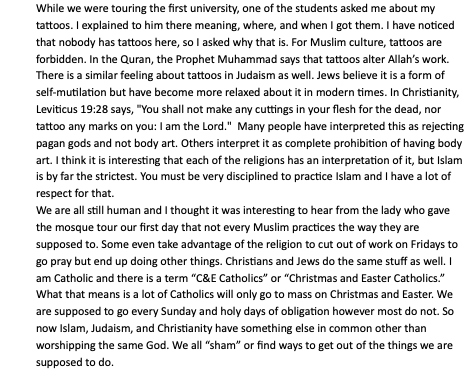Education Equality: Education and Literacy Gaps in Morocco
Throughout my lifetime, I have always had access to a quality education and schools that put effort into learning. My family also encouraged my educational efforts sparingly, where I always had access to a tutor whenever I needed it. In fact, females always performed better in my district, whether that be on standardized tests for the county or classroom exams. Girls in my classes always seemed to have a larger desire to learn, and the statistics showed it.
It came as a shock to me to see that this is not the case in other countries, specifically Morocco. "In 2018, the adult literacy rate in Morocco was around 83 percent among men and 65 percent among women" (Statista Research Department, 2024). This disparity has been a historical trend, in which many decades been have had more access to education.In Morocco, as in many parts of the world, cultural norms and socioeconomic disparities have historically conspired to limit opportunities for girls. Access to education remains a hurdle, particularly in remote rural areas where schools are scarce and the journey to knowledge is fraught with challenges. Compounded by traditional gender roles that prioritize boys' education, the cycle of inequality persists, echoing through generations.
Because of deeply ingrained cultural norms that favor boys' schooling over girls', gender disparities in literacy and education still exist in Morocco. Social norms demand that boys should have more access to resources and education from a young age, which feeds the cycle of inequity. Girls' capacity to regularly attend school is often compromised by the expectation that they prioritize domestic duties, such as taking care of younger siblings or organizing household chores. Additionally, certain communities' fundamentalist views of Islam uphold gender norms, which limits girls' freedom and educational prospects. The early marriage traditions that result in high dropout rates among girls are also influenced by cultural perceptions about the role of women in society. Furthermore, systematic prejudice is perpetuated by prevailing views about the relative worth of girls' and boys' educations.
Additionally, due to a combination of socioeconomic variables and restricted access to educational resources, gender differences in education and literacy are still present in Morocco's rural areas. Financial hardships are a common occurrence for rural families, which makes it difficult for them to place a high focus on education, particularly for females whose education may not be as important as that of boys. In addition, the problem is exacerbated by the geographic isolation of rural areas, where schools are frequently located distant from villages, resulting in lengthier commutes and higher transportation expenses, especially for girls. In rural areas, traditional gender roles are also more strictly enforced, with girls being expected to take care of the home rather than go to school. On the other hand, urban areas typically have stronger infrastructure, such as more resource-rich schools with highly educated teachers, which increases accessibility to education that accompany higher literacy levels for women (Kolovich and Ndoye, 2023).
Fortunately, government initiatives aimed at promoting girls' education and literacy programs are beginning to illuminate the path forward. Yet, the journey toward equality is not without its obstacles. Deeply ingrained attitudes and systemic barriers pose formidable challenges to the realization of educational parity. A comprehensive strategy is necessary in order to effectively close the gender gap in reading and education. In order to remove obstacles and foster an inclusive culture, community involvement, legislative changes, and focused interventions must come together. Through fostering an environment in which all children, irrespective of gender, have equal access to education, Morocco may fully realize the potential of its future generations, enhancing the country and advancing it towards a more promising future. Morocco: adult literacy rate by gender. (2023, June). Statista. https://www.statista.com/statistics/1321865/adult-literacy-rate-in-morocco-by-gender/#:~:text=In%202018%2C%20the%20adult%20literacy
Kolovich, L. L., & Ndoye, A. (2023, October 9). CHAPTER 9: Implications of Gender Inequality for Growth in Morocco. Www.elibrary.imf.org; International Monetary Fund. https://www.elibrary.imf.org/display/book/9798400225406/CH009.xml
Morocco: adult literacy rate by gender. (2023, June). Statista.
https://www.statista.com/statistics/1321865/adult-literacy-rate-in-morocco-by
gender/#:~:text=In%202018%2C%20the%20adult%20literacy


Comments
Post a Comment